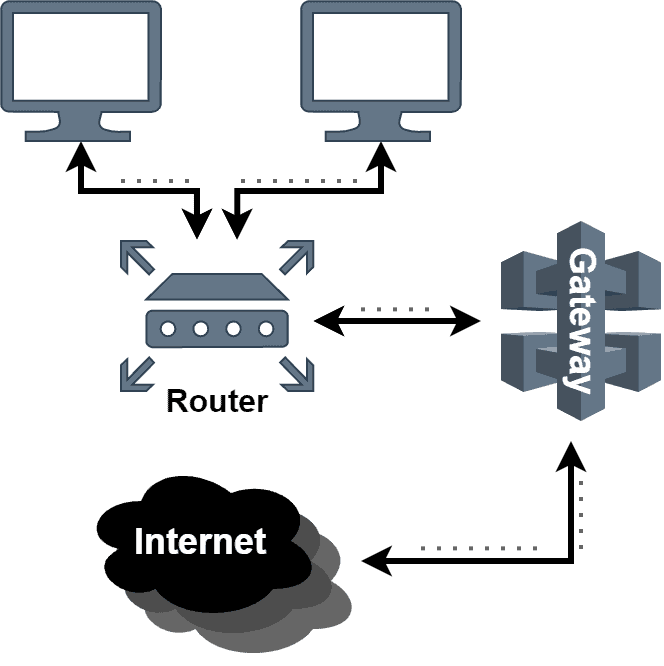1. 概述
在本教程中,我们将探讨网络安全部署中常用的两个设备:网关(Gateway) 与 防火墙(Firewall)。我们将分别介绍它们的功能、优缺点,并最终对比它们之间的核心差异,帮助你在实际场景中做出更合适的选择。
2. 网络安全简介
网络安全是指保护计算机网络及其资源免受未经授权的访问、数据泄露和恶意攻击的一系列技术和策略。它涵盖硬件、软件以及数据的安全,目标是保障网络系统的 机密性(Confidentiality)、完整性(Integrity) 和 可用性(Availability)。
网络安全通常包括两个主要方向:
- 网络加密:用于保护数据在网络上传输的安全;
- 网络监控:通过收集网络设备信息,实时检测可能影响安全的问题。
常见的网络安全组件包括:
- 网关(Gateway)
- 防火墙(Firewall)
- 入侵检测系统(IDS)
- 虚拟专用网络(VPN)
接下来我们重点分析网关与防火墙的工作机制及其优劣。
3. 网关(Gateway)
3.1 介绍
网关是连接不同网络之间的桥梁,负责在多个网络之间转发数据流量,并提供一定程度的安全防护。你可以把它理解为网络的“大门”,所有进出网络的数据都必须经过它。
网关的功能包括:
✅ 路由选择:根据数据包中的 IP 地址、端口号等信息决定数据转发路径
✅ 网络隔离:实现不同网络之间的隔离和通信
✅ 流量分发:将网络请求均衡分配到多个服务器上,提升性能并避免单点过载
如下图所示,网关在多个网络之间起到中继作用:

3.2 优点
- 网络分段与隔离:可以将网络划分为多个子网,提升整体安全性
- 负载均衡:将流量分发到多个服务器,避免单个服务器压力过大
- NAT 支持:通过网络地址转换(NAT)实现多个设备共享一个公网 IP
- 支持 VPN:可作为远程访问本地网络的安全通道
3.3 缺点
- 配置复杂:对网络知识要求较高,初次部署和维护可能需要专业人员
- 性能瓶颈:网关处理流量时可能引入延迟,影响整体网络性能
- 单点故障:一旦网关宕机,可能导致整个网络中断
4. 防火墙(Firewall)
4.1 介绍
防火墙是一种网络安全设备,用于检测并阻止网络中的恶意行为。它的主要功能是根据预设的安全规则,控制网络流量的进出,防止未经授权的访问。
防火墙通常部署在网络边界(如内部网络与互联网之间),也可以部署在主机上,用于防御内部和外部的攻击。
防火墙的规则可以基于以下条件进行过滤:
✅ IP 地址
✅ 端口号
✅ 协议类型(如 TCP、UDP)
✅ 应用层特征
如下图所示,防火墙位于网络入口,负责过滤进出流量:

4.2 优点
- 防止未授权访问:所有流量都必须经过防火墙检查,防止非法入侵
- 实时威胁检测:可以识别并拦截病毒、木马、DDoS 攻击等
- 灵活的流量控制:可根据业务需求定义细粒度的访问控制策略
4.3 缺点
- 配置复杂:尤其在大型网络中,规则维护和更新需要专业技能
- 性能影响:深度包检测(DPI)等操作可能引入延迟
- 过度依赖风险:仅依赖防火墙无法应对钓鱼、社会工程等绕过防火墙的攻击
5. 核心区别
| 对比项 | 网关 | 防火墙 |
|---|---|---|
| 过滤层级 | 网络层为主 | 应用层为主 |
| 吞吐能力 | 受连接网络带宽限制 | 可使用全带宽 |
| 用途 | 跨网络路由流量 | 防止未授权访问 |
| 保护范围 | 通常保护单个网络 | 可保护多个网络 |
| 功能 | NAT、协议转换、路由 | 包过滤、访问控制、威胁检测 |
| 类型 | 硬件设备为主 | 硬件或软件均可 |
| 数据处理 | 可以修改数据内容 | 仅能过滤,不能修改 |
6. 总结
本文我们详细介绍了网关与防火墙的基本概念、优缺点及其核心区别:
- 网关 主要用于网络之间的通信和流量管理,强调路由和转发;
- 防火墙 专注于安全防护,侧重于访问控制和威胁检测。
在实际部署中,两者往往配合使用,网关负责流量调度,防火墙负责安全过滤,共同构建一个安全、高效的网络架构。
✅ 建议:不要只依赖单一设备,应结合网关、防火墙、IDS/IPS 等多种手段,构建纵深防御体系。
⚠️ 踩坑提醒:有些团队只关注防火墙而忽视网关配置,可能导致流量瓶颈或安全策略失效。